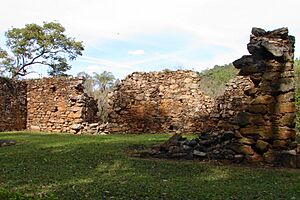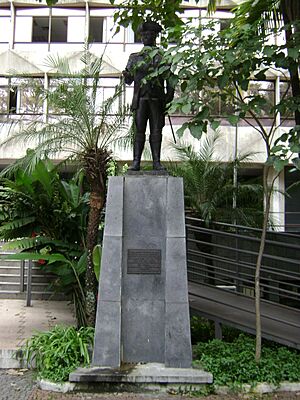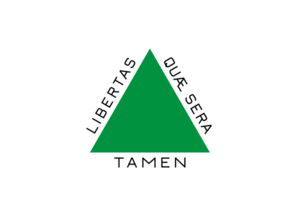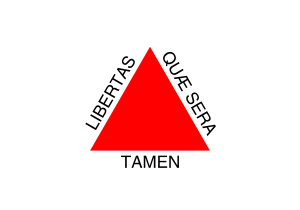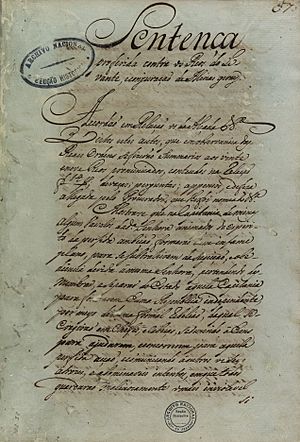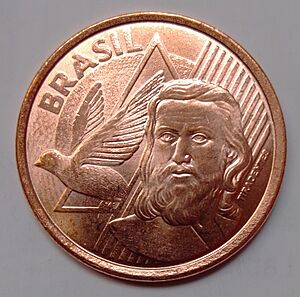Tiradentes facts for kids
Quick facts for kids
Tiradentes
|
|
|---|---|
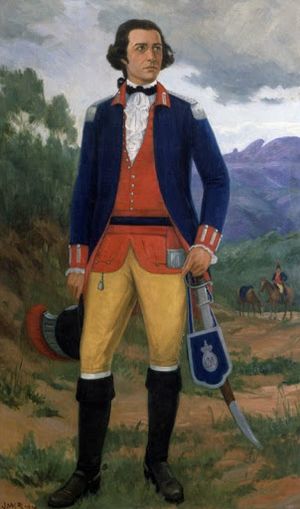
Tiradentes in uniform of alferes, by José Wasth Rodrigues (1940). No contemporary portraits or physical descriptions of Tiradentes are known
|
|
| Born |
Joaquim José da Silva Xavier
12 November 1746 Fazenda do Pombal (Ritápolis), Minas Gerais, Portuguese Colony of Brazil
|
| Died | 21 April 1792 (aged 45) |
| Movement | Inconfidência Mineira |
Joaquim José da Silva Xavier (born November 12, 1746 – died April 21, 1792), known as Tiradentes, was a key leader in a Brazilian revolutionary group called the Inconfidência Mineira. This group wanted Brazil to become fully independent from Portuguese rule and create its own republic. When their plan was discovered, Tiradentes was arrested and publicly executed.
Since Brazil became a republic, Tiradentes has been seen as a national hero. He is also considered the patron (or protector) of the Military Police in Brazil.
Contents
Who Was Tiradentes?
Joaquim José da Silva Xavier was born on a farm called Fazenda do Pombal. This farm was near a village in the area known as Minas Gerais, which was then a Portuguese colony. He was the fourth of seven children. His father was from Portugal, and his mother was from Brazil.
His family owned a large farm and had many slaves who worked there, including in mining. The farm also had a special place for prayer, slave living areas, and shared kitchens. They also had a lot of valuable mining tools.
His Early Life and Work
When Tiradentes was 9 years old, his mother passed away. He moved with his father and brothers to a town called São José. Two years later, when he was 11, his father also died. Because his parents died young, his family lost their property due to debts.
Tiradentes did not have a regular education. He was raised by his uncle and godfather, Sebastião Ferreira Leitão, who was a dentist. Tiradentes worked in different jobs, including as a traveling seller and a miner. He also became a partner in a pharmacy. He learned a lot about dentistry and pharmacy, which is how he got his nickname, Tiradentes. This name means "tooth puller."
People said he was very skilled. One person, Brother Raimundo de Penaforte, wrote that Tiradentes "decorated his mouth with new teeth which he made himself that seemed natural." He also sometimes worked as a doctor. He learned about medicinal plants from his cousin, Brother José Mariano da Conceição Veloso, who was a famous botanist.
Why Did Tiradentes Become a Revolutionary?
Tiradentes used his knowledge of minerals from his mining work to get a job as a land surveyor for the government. Later, he joined the Minas Gerais Dragoon Regiment, which was a type of military unit. He was put in charge of a small group and sent on missions along the "Caminho Novo" (New Road). This road connected Vila Rica (the capital of Minas Gerais at the time) and Rio de Janeiro. Gold was sent along this road to the coast, and then shipped to Portugal.
Growing Discontent with Portuguese Rule
As Tiradentes saw goods moving along the Caminho Novo, he started to feel that Portugal was taking too much gold and other valuable resources from Brazil. He believed Brazilians were being unfairly exploited. He was also unhappy with his own low rank in the military. He was not from a noble family, so he was never promoted beyond alferes, which was the lowest officer rank. Eventually, he was even removed from his command.
His trips to Rio de Janeiro also connected him with people who had lived in Europe. These people brought back new ideas about freedom and government.
The Inconfidência Mineira Movement
In 1788, Tiradentes met José Álvares Maciel, who had just returned from England. Maciel had seen how much England's industries were growing, especially during the Industrial Revolution. He compared this to the poverty in colonial Brazil. They decided to form a group of people who wanted freedom.
This group was led by religious leaders and other important Brazilians, such as Cláudio Manuel da Costa, Tomás Antônio Gonzaga, and Alvarenga Peixoto. They spread their ideas among the people.
At this time, Portugal demanded a lot of gold from Brazil. However, the gold mines in Brazil were producing less and less. The colony was not meeting the "quinto," which was the amount of gold the Portuguese Crown demanded. This made Portugal put more pressure on Brazil. This led to the "derrama," a very high tax that took a lot of people's wealth. This tax made many Brazilians even more upset and ready to rebel.
Tiradentes was influenced by the writings of Jean-Jacques Rousseau and the American Revolution. He joined the Inconfidência Mineira, a revolutionary movement. They dreamed of an independent Brazilian republic. They wanted São João del Rei to be the capital and Vila Rica to become a university town. The flag they proposed for the new republic had a green triangle on a white background, with the Latin phrase "Libertas Quae Sera Tamen" ("Freedom, Even If It Be Late").
The Discovery of the Plot and Its Outcome
Tiradentes and his group planned to start their rebellion in Vila Rica on the day the "derrama" tax was due, in February 1789. They thought people would be most angry and ready to revolt then. However, one of the conspirators, Joaquim Silvério dos Reis, told the authorities about the plan. He did this to get out of paying his own taxes.
The governor of Minas Gerais immediately canceled the "derrama" tax and ordered the arrest of the rebels.
The Trial and Execution
A trial was held, which lasted almost three years. Tiradentes and ten other members of the Inconfidência Mineira were sentenced to death. However, Queen Maria I of Portugal later changed the sentences for most of them. She changed their death sentences to permanent banishment (being sent away from the country forever).
But Tiradentes's case was different. He took full responsibility for the entire movement. Because of this, his death sentence was not changed. He was imprisoned in Rio de Janeiro and then executed on April 21, 1792.
Tiradentes: A National Hero
Tiradentes began to be seen as a national hero by people who supported a republic in the late 1800s. After Brazil became a republic in 1889, the anniversary of his death, April 21, became a national holiday.
His nickname, "Tiradentes," has been used to name many places. There is a city in the state of Minas Gerais named after him. City squares in Belo Horizonte, Curitiba, São Paulo, Rio de Janeiro, and Ouro Preto are also named Tiradentes. Even a major avenue in Santo Domingo, Dominican Republic, carries his name.
The 11th Mountain Infantry Battalion of the Brazilian Army is also named the "Tiradentes" Regiment in his honor.
See also
 In Spanish: Tiradentes para niños
In Spanish: Tiradentes para niños
- Zica family, descendants of Tiradentes
- Toussaint Louverture
- Simón Bolívar
- George Washington


